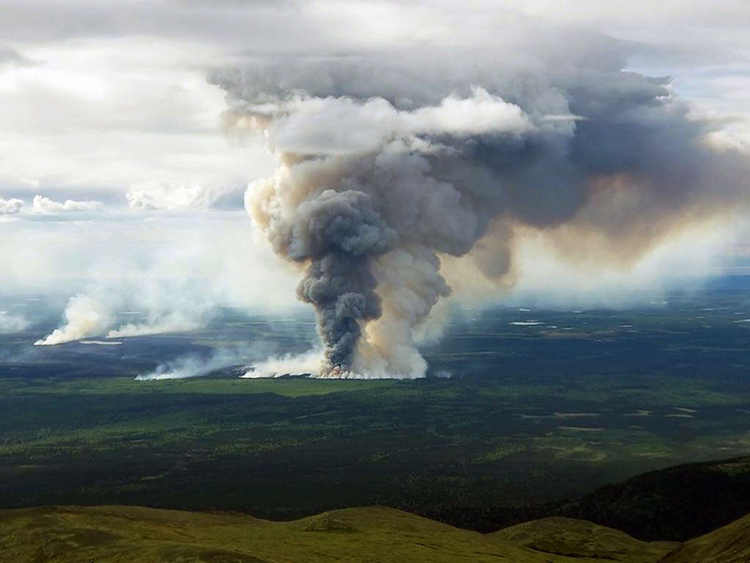Wildfires have enabled boreal forests in North America to become a major carbon source which will likely only get worse
05-13-2021

A smoke column on the northeast side of the Swan Lake Fire as seen on Monday, June 17, 2019. Photo by Casey Lasota / Alaska Division of Forestry
Forests around the world are known to emit and consume carbon. The balance of carbon depends on the rates of emissions and consumption. A recent publication in Scientific Reports by Purdue EAPS Professor Qianlai Zhuang and PhD student, Bailu Zhao, use satellite data and a mechanistically-based biogeochemistry model to quantify the impacts of wildfires on carbon cycling in North America boreal forests.
Boreal forests are high-latitude environments where freezing happens for half (or more) of the year and typically are covered in hardy conifer or broad leaf trees. Zhuang and Zhao find that North American boreal forests are a major carbon source due to wildfires that have happened between 1986 to 2016. Because wildfires are happening more frequently and burning larger areas of forests, this trend is likely to continue. Because of the increased frequency of wildfires, the North American boreal forests cannot assimilate enough carbon to balance that which has been emitted by the fires.
Dr. Zhuang’s lab area of study is Earth system modeling. This study focused on northern North American boreal forests as part of a funding project through NASA’s land use and land change program. Currently, the team is working with remote sensing scientists to further develop fire burn areal and severity data for whole northern high latitudes regions. Their goal is to adequately quantify the fire impacts on carbon cycling in the northern high latitudes and further assess their impacts on our climate system.
“Forest fire occurrences and severity are found to be related to temperature and soil wetness at different seasons,” says Zhuang. “Changing climate appears as a key reason of the more frequent and severe fire in the recent years in the region. There might exist a positive feedback loop between climate warming and wildfires. More greenhouse emissions due to immediate and subsequent fire emissions will trigger warming, which in turn will lead to more fires and higher severity. Improving our ability to detect fires using satellites could help prevent large and severe fires. However, wildfires in these regions are often remote and difficult to control.”
To understand how fires contribute to the amount of carbon, Zhuang explains that “plants assimilate atmospheric carbon through photosynthesis into plant tissues. Some carbon will be respired back to the atmosphere through plant respiration. Dead plant tissues are added to soils, which are decomposed by microbes, releasing carbon-based greenhouse gases mainly including carbon dioxide and methane. Fires also change soil wetness and soil thermal conditions, which often enhance soil microbial activities, accelerating soil carbon release. Thus, forests will act as a carbon source to the atmosphere. They find that wildfires directly release 57 million tons carbon per year from North American boreal forests in the 30-year period. Together with the loss of carbon from soils after fire, these forests release about 3 billion tons carbon to the atmosphere. In contrast, if not considering fire disturbance, these forests act as a carbon sink, which is not a correct quantification.”
He concludes that the current knowledge is that fossil fuel emissions dominate the total carbon release to our atmosphere. Under the Paris climate agreement, each country has set up its release reduction target. He says that “these fire emissions will require the nation to further cut its fossil fuel emissions, complicating our economic and climate policy making.”
Written by Cheryl Pierce